
BAIANASYSTEM
O MUNDO DÁ VOLTAS (Self-published)
My favorite Brasilian band has really come of age on their latest (fifth apparently) album, O Mundo dá Voltas, which means "the World keeps Turning" in English. It is beautifully arranged and sequenced and shows great poise and maturity in its delivery. I don't even object to the rap numbers which usually make me skip ahead on contemporary albums. This time ("Magnata/Tycoon") it is followed by a lovely acoustic duet between guitar and cavaquinho ("Palheiro/Haystack"). There is an evocative "making of" video, mostly in black and white. But the video is marred by too many overlays: sonic pulse bars run up and down the outer edges, there are blurry titles all over the image in orange script, and along the bottom, logos, plus the date MMXXV and more anchor text as well as the lyrics, which might be useful if you really understood Portuguese, but printed in a large hideous blackletter script in yellow! It's a noisy graphic mess. After half watching it a couple of times, I was able to download the album and can listen to it undistracted. Their "classic" layered Baiana sound: bright guitar lead with horns in counterpoint, a battery of surdo drums with echo, emerges on the third track "Praia do futuro" (a beach in Fortaleza)", which has guest vocals from Seu Jorge. A reggae-flavored number "Porta-Retrato da familia Brasileira" returns to constant themes: the hardship of the average family. I transcribed and translated some of the lyrics:
A primavera chegou / Spring has arrived
Améfrica, Améfrica / Améfrica, Améfrica
Ladina Améfrica / Ladina Améfrica
na minha casa e malê / in my house and malê
eu continuo na fé / I continue in faith
eu vou fazendo fazer / I'm doing it
Rimando contra a mare / Rhyming against the tide
Quilombola Quilombo / Quilombola Quilombo
Explanation: There was a major slave revolt in Salvador da Bahia in 1835. The leaders were muslims who were known as malê, the Yoruba word for muslim. (In 2000 the bloco I hung out with in the bairro de Itapuã was called Malê Debalê.) Améfrica is a made-up word to signify Africans in America, this is reinforced by "Ladina" (Ladinos are mestizos in Central America, as well as a name for blacks in medieval Spain); Quilombo comes from the Kimbundu word meaning war camp and refers to hidden camps in the bush created by runaway slaves, who were called maroons in Jamaica or Carabalí in Cuba and Puerto Rico. Arsenio Rodriguez's first hit "Bruca maniguá" begins "Yo soy Carabalí, negro de nación. Sin la libertad, no puedo vivir."
The Bahian elder statesman, Gilberto Gil, shows up to sing "Pote d'água (Bring water)." The layers of berimbau with the Orquestra Afrosinfônica are lovely. The complex arrangements also have swelling brass and the majestic outtro of the title track, "O Munda dá voltas" would make Gil Evans proud. Despite a brief rap interlude, I dig "Bicho solto" (I am going crazy) or literally "loose creature," which demonstrates the barely contained restraint on the verge of explosion that is so characteristic of life in Bahia, especially around carnaval. In fact the album is redolent of Salvador da Bahia and very evocative of the moods of the city. This is outstanding and definitely one to play on repeat.
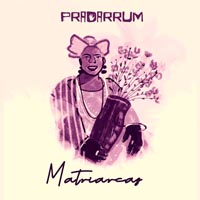
GABI GUEDES E PRADARRUM
MATRIARCAS (Qobuz)
Gabi Guedes is a percussionist from Brasil. He started playing conga at the age of ten and now has over 50 years of experience performing. For this Afro-Brasilian album celebrating black mothers, he put together a group called Pradarrum to showcase a range of style, including jazz and traditional terreiro songs associated with Candomblé rituals. There are two female singers, Ellen Oléria and Márcia Short as well as acoustic and electric guitar, trombone and trumpet players and, of course, a lot of percussion. The balance is great and the jazz quotient high, although of course the pundits will claim it's "afro-beat" to try to push up sales. With ten tracks, a couple of them covers, the group range through samba and funk styles as well as jazz, but always reaching back to their Angolan roots. "Senhora mãe" brings a clarinet to the fore, while "Pèrègún" brings the trombone up front; the backbeat on this track is astounding, reminding me of Jamaican Burru drumming, no doubt there is a connection. In fact the guitar on here also reminds me of Ernie Ranglin so perhaps they decided to dub it live. You can watch a recent live performance here. I can't find this album on bandcamp, in fact he does not seem to have a label, but it is available to stream and download on Qobuz.

AGUIDAVI DO JEJE (Bandcamp)
Twenty-five years ago, on my third trip to Bahia, Brasil for carnaval, I saw Gilberto Gil parading with the bloco of Filhos de Gandhy. He was already a big star and stood out from the identically dressed devotees in their blue and white robes, blue beads & white turbans. They looked like a walking ad for laundry detergent. These traditional percussion groups (afoxés) are an important part of carnaval in Bahia as they keep continuity with the Afro roots of the music, performing with mostly drums and shekeres. They also connect to the pacifist message of Gandhi-ji, having been formed in 1949, the year after he was assassinated. Since I last saw Gil he became Minister of Culture in Lula's government, but kept appearing and playing both his pop Tropicalismo as well as rootsy folk music with acoustic guitar. Now he has teamed up with Luizinho do Jêje and his group Aguidavi do Jêje for an evocative set of lyrical music. While he is only on one track, Gil's spiritual sensibility permeates the disc. There's a heavy percussive underpinning with the agogô (the two tone cowbell of the Yoruba in West Africa), hand claps, conga drums, backing a local stringed gourd, known as the violão de cabaça, or calabash guitar. There's even a rainstick which makes it uniquely Brasilian, though you can also easily identify this as African music. It is not religious or ceremonial, rather a celebration of life and joyful self-expression, however you know the Orixás are listening! Jêjes were slaves from Dahomey (present-day Benin) brought to Brasil, while Aguidavi is the name of the drumstick used to beat the three ritual drums of Candomblé music. In 1835 there was an insurrection of slaves in Bahia, this event, known as Malê, not only defined Bahia as a seat of rebellion but set it apart as almost an African enclave within the New World. Part of the lyrics use onomatopoeia, words from the old vocabulary handed down in Dahomean oral memory, used in call and response vocals. The acoustic guitar helps knit it all together into an exciting event.
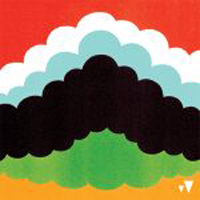
BIXIGA 70
VAPOR (Glitterbeat)
2023 has been a thin year for new music. After a 4-year break (I think we all took a break for the pandemic), Bixiga 70 return with their fifth album, Vapor. The São Paolo-based 10-piece big band are masters of the Afro-Brasilian sound. Their neighborhood, a former slave quarter of the capital, had a big influx of Europeans 100 years ago, and more recently Nigerians and other refugees have come of their own free will. There is a hint of Fela's Egypt 80 in some of their horn choruses, but the similarity is superficial, as they bring synths and Brasilian percussion to the set for a big glossy sound that has evolved beyond Afrobeat. The bass and guitar are busy but don't dominate, allowing the lyricism of the horns in counterpoint to lead the line. The guitar does lead the way with a jagged riff on "Marginal Elevado Radial," which makes me think of their counterparts up north in Salvador, Baianasystem. But then the horns make their move. In addition to their two percussionists they have four guests on drums and percussion, plus a third sax to join their trumpet and trombone. One of the guest percussionists is Simone Sou who has done a lot for women's empowerment in the Brasilian music scene. She plays what sounds like bells or a big gamelan, on the opening and closing tracks. The wormy synth has a lot to say, occasionally getting in your face (as on "Mar Virado"). The keyboard player, Pedro Regada, is new since the last album, Quebra Cabeça (2018), which had Hammond organ, Farfisa and other classic sounds. His tweaky synthi whoops (especially on "Na Quarta-feira") are less engaging though and turned me off. In addition to rainsticks you can hear a berimbau in the final dreamy piece "Loa Lua," which evokes jungle thickets, with the horn chorus on the prowl. My final assessment is the first and last tracks are really good, but the busy synth overwhelms the middle parts.
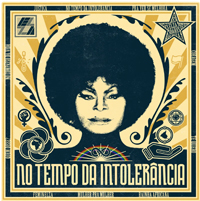
ELZA SOARES
NO TEMPO DA INTOLERANCIA (Deckdisc)
Elza Soares was working on this album "In the Time of Intolerance" at the time of her death in January 2022 at the age of 92. She had enjoyed a late-career revival and in this final round-up sings material sent to her or co-written by Ivone Lara, Rita Lee and Roberto de Carvalho, and other, mainly women, Brazilian composers. Josyara from Bahia helped finish up the work. After Elza sent her some lyrics she agreed to collaborate, adding guitar and writing the brass arrangements. The production is a bit more lush, with overdubbed strings, and less hard-edge funk rock than on her come-back albums, The Woman at the End of the World (2015) and God is a Woman (2018), though her voice is as brittle as ever. In her seven-decade career she covered all the styles from early Carioca sambas to the wild punk screaming that announced her return at 85. She became a voice for the oppressed, speaking out against racism, social inequality and violence against women. Towards the end of her life Brazilian society was in retrograde with Bolsonaro, the "tropical Trump" acting like a pig, allowing cronies to burn the Amazon, denying there was a pandemic, attacking gays, etc. There is a strong feminist message in her lyrics, and those she drew from her collaborators for this final outing. Her words include this: "They say I'm controversial/ As Luther King used to say/ If you want an enemy/ Just say what you think."
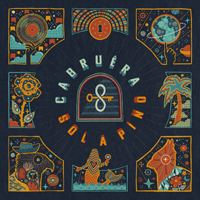
CABRUERA
SOL A PINO (Polen Records)
Formed in 1999, Cabruêra come from Paraíba in Northeastern Brasil so their music is not from the Samba or Axé traditions. Their blend of traditional music, progressive rock and ska, known as mangue beat, is one of the better lesser-known styles of enjoyable Brasilian music. This is their sixth album and the band, a quartet with guests, has become very polished in delivery. There's a high level of studio sophistication in the production with clever layering of sound. The songs are short and well arranged so they flow together. By the time of "A Vida" (which was the first single off this album) we are starting to groove on the building fat horn riffs and the percussive almost disco-like guitar, set off against one-drop drumming. Cabruêra's singer Arthur Pessoa does not have a very strong voice, in fact he struggles to hit some notes, but he is a really fine songwriter and this album is full of good melodies and catchy hooks. Violin and accordéon deliver us a mournful ballad called "Pasarinho (little bird)" which is quite lovely and moving. The guitar is used percussively, as in reggae, the lead being taken on trombone, or in "No Mar (To the sea)" on a slide guitar. The instrumental title cut, "Sol a pino" (roughly High noon, or Sun high in the sky) reminds us of Northeastern Brasil with jangly percussion on a triangle, a guitar that sounds like it's being bowed (but is being played with a ball-point pen), and accordéon. But wait, what's this? berimbau joins Pessoa's accordéon on "Clareou (shed some light)." A truly fine outing from Cabruêra.

BAIANA SYSTEM
OXEAXEEXU (Self-published)
Although the black and white cover with its stark title logogram suggests this is a cryptic word game or even an alien script, it's the words Oxé, Axé, Exu, pronounced O'Shee (!woah!), Ashay (a type of Brasilian pop from the 80s with drumming, reggae and even Candomblé overtones, indicative of good vibes), Eshoo, the name of the Yoruba god, trickster, messenger, keeper of the crossroads, worshipped in Candomblé, liable to mess you up, whom I presume will appear if you thus summon him. This band is big in the favelas of Salvador da Bahia, and this may explain why they give away their music. Another important favela band, Olodum, a drum ensemble formed in 1986, named for the supreme Yoruba god, Olódùmarè, is also heavily influenced by samba and reggae. But BaianaSystem go beyond this to add electronics, samples, and rap, while creating a great flow for the duration of the disc. It opens with a characteristic tune which could have been on their previous albums. The bloco of repique drummers is there, with bright layered guitar notes, and a call and response rap with BNegão and wild clarinet, all piled on a basic "Manicero" riff. This is the well-situated opening cut, "Reza Forte," guaranteed to please their fans. I love it.
There are 21 tracks, some just a minute or two to express a mood or idea that floats by (like the old woman invoking the saints on the second cut), interspersed with radio static and other suggestions of transience. The group is also flexible, based around guitarist Robertinho Barreto, who plays a small 5-string "baiano" guitar – half-way to a cavaquinho – bassist Marcelo Seco, electronic percussionist Wilson Batata and DJ João Meireles, mixer. They also have a graphic designer in their entourage who provides a pleasing, hip graphic identity. The African and Brasilian influences are strong but so is the pervasive dubbing from Jamaica which pushes the notion of the "trio electrico" well into the 21st century. One track, "Nauliza," brings in a rapper, Makaveli, from Dar, Tanzania. Chico César added his voice, from Uruguay, and a bandoneon player sent his part from Argentina. The other guest who is a known factor is Céu whose debut came out on Six Degrees in the US; she sings about feelings: "O que não me destrói me fortalece (What doesn't destroy me makes me stronger)." I always think singer Russo Passapusso sounds like an old pirate and he doesn't let me down, singing about pirate booty on "Tubarão." You can also watch it live here. There is a fair amount of filler, with all the collaborations and experiments, making this more of a collective effort than a single BaianaSystem album, but they way it's been anchored with strong tracks at the beginning middle and end holds it together.
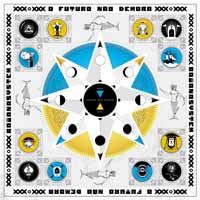
BAIANASYSTEM
O FUTURO NAO DEMORA (No label)
I thought I had downloaded this, but this band is tricky, they don't sell CDs: you can stream the album free on many platforms such as Spotify but it remains intangible and for me artifactuality is an important element of music. Not just the possession factor but for classification, filing and retrieval. (My last computer meltdown wiped out a lot of music I had stored on it.) As innovative as their 2016 Duas cidades, this album has hip hop lyrics delivered over a strong dubby bass and Afro-brasilian drumming, with a wash of Hammond organ, electronica, a real horn section and a light rinse of berimbau and other instruments local to Salvador da Bahia, the colorful heart of Brasil. Among the tropical rhythms there is a lot of modern samba and even afoxé, also called ijexá, recognizable in the repique drum riffs on the downbeat. For this they enlisted a bloco of ten drummers! But in general they wear the folklore lightly, adding irresistible guitar hooks and the oddly insistent synth keyboard part guaranteed to give you earworms. Adrian Sherwood was brought aboard to tinker with the dub aspects of "Navio," where vocalist Russo Passapusso sounds like an old pirate. "Bola de cristal (Crystal ball)" and "Sulamericano (South American)" are stand-outs. The latter features Manu Chao and recaptures the excitement of their first hit "Playsom." The new album is titled "The Future wont wait." Their message is a heartening reaffirmation of the urgent necessity of ecological salvation, so important in this day and age.
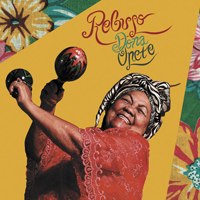
DONA ONETE
REBUJO (Mais Um Discos MAIS037LP)
I honestly don't know how these "old timers" like Dona Onete do it!@ From the opening of "Festa do Tubarão" she is up and running while her band twist an intense ska-like groove tightly around the vocals. A children's book author, folklorist and former history teacher, Onete now tours the world with her romping band which brings the Amazonian sounds of carimbó and bangue to the world stage, along with more familiar rhythms like cumbia and samba. At 80 she seems unstoppable and still manages to "mexe mexe" which means "shake shake." Flute and cavaquinho are featured in "Musa Da Babilônia" which includes a duet with B Negão, a rapper from Rio. True, she has a world-weary voice but it is offset by the sharp band and their tight as clockwork delivery. Marcos Sarrazin is notable on sax, keyboards, flute and guitar.
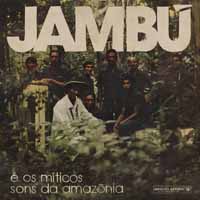
JAMBU
E OS MITICOS SONS DA AMAZONIA (Analog Africa AACD088)
Sit back and relax and enjoy the latest episode of crate-digging adventures with Samy ben Redjeb. Having exhausted West Africa, for now, Samy is back in the Brazilian rainforest from whence came the exciting Mestre Cupijó compilation from Analog Africa six years ago. Jambú is a stimulating plant, akin no doubt to coca, which promotes the appetite; it's also added to the deadly distilled sugarcane hooch known as cachaça. This album will stimulate your ears. Hits of tropical psychedelia mix with choro, samba, merengue, even the lambada. Pure percussion backs all these tracks and there are no synths, so none of the cheezy disco-tinged stuff that was coming out of Europe and Africa in the late 70s penetrated the rainforest. The compelling "Coco da Bahia" by Pinduca is based around an insistent riff that reminds me of "Ode to Billy Joe," Bobbie Gentry's 1968 hit. But this one has no bridge. "Carimbó da Pimienta" -- the track that started Samy on the quest for the story of this music from Belém and environs -- has a lot of what I'd call Angolan feeling. And again he has done a thorough job, not just in tracking down the tunes, but finding the artists, many of them surprised that someone from so faraway had come to interview them and find out their story. Another Carimbó track, "Lundun da Yaya" by Grupo da Pesada jumps off the album, and makes you want to put it on a loop. There's a great backbeat on some big zabumba bass drums, shakers and a wobbly horn chorus. He ends with a wild live track from Mestre Cupijó which is thoroughly engaging in its sloppiness. Triumphant.
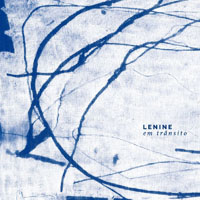
LENINE
EM TRANSITO (Mameluco productions)
Arguably one of the best singer-songwriters working today, Lenine's career is hampered somewhat by the fact that his songs are in Portuguese which to most people sounds like the deaf-mute version of Spanish. To compound the problem he writes poetry that is full of internal rhymes and puns, so google translate is at a loss regarding what he is saying. "Ogan ere," which has mouth percussion in harmony and a single drum backing, is translated as "hehehe," and the euphonious line "Bate ate couro doer" is rendered as "Beats until leather ache." His latest album was recorded live in a theatre in Rio de Janeiro in February 2018. The mix is superb and the musicianship top rank. This band has been with him for a couple of years now. He is backed by two guitarists who also do programming and backing vocals, a bassist who also plays synth and vocals, and a drummer. Amaro Freitas plays piano on the ballad "Lua candeia (moonlight)". Brasilians love to sing along, which ruins many live albums, so the only way to get away with it is to do a set of all new material. The first song, "Leve e suave," admonishes us to travel light and live in love. The horns on "Intolerância" sound live, but are uncredited. This uptempo single reminds me of The Specials although it doesn't really have a ska beat. "She is still cursing me" he sings. My friend Zeca who stays atop the music scene in Brasil commented that the sonic wash provided by the synthesizers is also calculated to drown out the audience's attempts to sing-along, so they are being pro-active about creating an original sound that is also a defense against the quirks of performing. The versatility of the band make every song distinct and Lenine's vocals are alternately wistful and forceful. Another triumph.
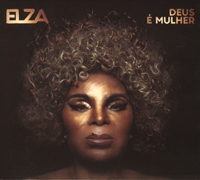
ELZA SOARES
DEUS E MULHER (Polysom)
I think of this as Soares' second album though it's actually her 35th! Back in the 1960s she recorded sweet samba songs on Odeon and was married to Garrincha, Brasil's second-most famous footballer. In 2017 she electrified a whole new audience with her punk-samba "A Mulher do Fim do Mundo (Woman from the end of the world)." Now the octogenarian has followed up with another hard-ass set of scorching songs that sound more like indictments, delivered in her world-weary tone. She was probably nodding off with samba tributes when this new wave overtook her and she is up to giving it her all, yelling over the thundering drums and screeching guitars. God is a Woman is her message. The band, who have previous form in this department, are intent on mayhem. They are the perfect accompaniment to her gravelly delivery, though from time to time, as on "Lingua solta (loose tongues/language)," they get positively orchestral. Berimbau shows up with needle-jagging guitar and lush ominous strings for "Hienas na TV (Hyenas on TV)." The Duchess thought Soares sounded like Bob Dylan; dissonance rules, but there are some bright moments in the din.
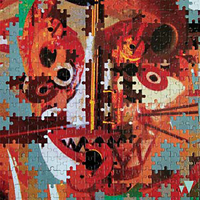
BIXIGA 70
QUEBRA-CABECA (Glitterbeat GBCD063; also 2xLP)
The title of this album translates to Puzzle but the portuguese literarily says, Break your head, which is a popular game with the headbangers south of the equator. The fourth album from the Paulista big-band collective, it's bold and brash but also melodic. Their roots may be in candomblé, the Afro-Brasilian religious and ritual music, but their foot is on the pedal when it comes to jazz funk. Touring and playing for eight years has sharpened their chops, and the fact they've played with the likes of Ghanaian Pat Thomas and Nigerian O.J. Ekemodé gives them an inside track on making a big Highlife sound without seeming like another Fela tribute band. Their Brasilian side is manifest in influences from João Donato. In addition to treacly thick drums, the horns layer up in a rich tasty cake with the skittering guitars as the frosting on top. While it is instrumental, the horns take the vocal part (I love the solid baritone sax underpinning) and are arranged intricately as the guitars lurk waiting to come back to the fore. The album is also geared like a live set with three danceable numbers followed by a break in tempo, with organ, skanking guitar, and congas & triangle to the fore for the first minute of "4 Cantos," then it starts to heat up again. There's a dose of 60s psychedelia with burping mad-scientist synth in "Primeiramente" and again in "Camelo"; I could have done without these, but they don't stray off the path for long. Afro-Brasilian percussion underpins the closer "Portal" with lyrical guitar, mellow organ, dreamy horn incursions: this is bliss. The musicianship is exceptional, every element coming in loud and clear on the clean recording.
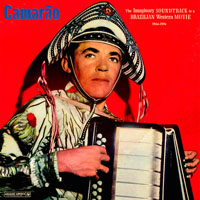
CAMARÃO
IMAGINARY SOUNDTRACK TO A BRAZILIAN WESTERN MOVIE (Analog Africa 25)
Samy ben Redjeb jets off to the Sertão of Northeast Brasil and returns with an invigorating collection of accordeon hits from the decade 1965-75 in a new departure for his groundbreaking label, Analog Africa. He refers to a Western Movie in the title and it's not far-fetched: the deserts of the Nordestino do resemble the wild west and are also full of legendary figures like Lampião, a cross between Robin Hood and Jesse James. Lampião is the subject of folk ballads which are sung and gathered in chapbooks called Livros do Cordel, one of the great surviving folk art forms of South America. Those ballads, a bit like decimas, are hard to take at length, however, unlike the delicious forró which has elements of brass band, with seductive clarinet and exclamatory triangle romping along with accordeon and a resounding bomp on bass drum. I recently had my old dead Mac brought back to life and was to pleased to think most of the acres of lost music files were intact, but when I started digging them out, iTunes had only kept the first track of many albums. In this era of evanescent digital music it's nice to hold the album in your hands, whether you are into vinyl LPs or CDs with a fat booklet to give you the context for the music you are listening to. Young people are getting into books, apparently, so perhaps artifacts are not so obsolete, and while I don't have much faith in the durability of my CD collection, I know where stuff is. Also LP sales are on the rise again, helped along in part by vinyl issues from Analog Africa (not to mention Matsuli, Teranga Beat, Crammed Disc and even Buda are planning a compilation album based on their fabulous Zanzibara series). Drawing from 6 albums released between 1964 and 1974, this disc presents a great selection of quintessential forró music. Camarão started modestly with a triangle and zabumba (bass drum) to accompany his accordeon but his band expanded to include 4 percussionists, 3 saxes, 2 trumpets, 2 trombones, 2 guitars and 2 singers, so he fed a large family in his decade in the spotlight. The various configurations give the compilation depth and variety, and a definitive cinematic flavor: the whole thing is a joyous celebration.
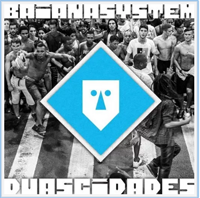
BAIANASYSTEM
DUAS CIDADES (free on line)
My pal Zeca told me to check out this group, Baiana System: I gave it a cursory listen and said, nah, too techno for me, thanks. Then I stumbled across their video for carnaval 2017, "Invisivel," which got under my skin and I decided to give them another listen. Like many other bands they give away their music since they know people will steal it if they can, so you can check it out for free. One hopes this promotes them to the point where they get more gigs and that pays for their time and effort. This album is firmly rooted in their home turf: Cidade Alta and Cidade Baixa of Salvador da Bahia. The Duas Cidades (two cities) sit on the Bay of All Saints from which they get their name, and are separated by an old lift: the Lacerda elevator which takes you up from the bay to the precincts of the beautifully preserved 17th-century town on the cliffs above (a UNESCO world heritage site). When I first went there 20 years ago the Lonely Planet guide said, Avoid the ruined old city at night because it's full of thieves and prostitutes, so I figured that was the place to go. And I was right, I loved it on sight. Baiana System have a nice touch on the one-drop reggae, with post-Adrian Sherwood effects. In fact the album starts in the middle of a dubby piece with tasty piano and squeaky jazz clarinet riffs bouncing off a prowling bass line and very busy drums. You feel like you opened the right door late at night to a welcoming little bar off a cobbled side street in Pelourinho. The band are cooking and you are not yet too intoxicated to appreciate it. "Playsom" is a reggae/axé hybrid and the drummers really merge well, even adding in some Style Scott drum fills before a crashing dub comes in. In addition to the samba-reggae there are some more -- what's the word? traditional -- hip hop type tracks, including a tribute to Fela Kuti.

ELZA SOARES
THE WOMAN AT THE END OF THE WORLD (mais um discos MAIS 031CD)
This is the 34th album by this Brasilian icon: the septuagenarian "Queen of Samba." I have lived in Brasil and never heard of her, but then what do I know? Gay black women were never allowed a voice before this century. Her style of music is called "Samba sujo" or dirty samba, and she has the gravelly vocals to deliver on that promise. Her backing band on this are Paulistas who bring rock, free jazz and noise to the party. They wrote the tunes for her, and the theme of the album is "carnaval as the apocalypse," which definitely accords with my experience of carnaval over three successive seasons. I remember flying into São Paulo and as the plane lowered into the city approach I could see the polluted rivers glowing ominously like radioactivity and small fires burning in waste ground sending out acrid black smoke, it really looked like a scene out of Hieronymus Bosch. Now, with that backdrop, imagine a 70-year-old woman who has had an inordinately tough life singing like a weary punker with a bunch of out-of-control guitars and electronica over chugging drums and punch drunk horns. Maisumdiscos (literally "one more record") have a thing about reinvigorating the careers of elderly ladies, which is great when they can sing, like Elza and the amazing Dona Onete, I just wish they would put a bit more effort into the packaging: the sterile black on white lettering is wretched and doesn't suggest anything like the passionate content. Here, I doodled this alternate cover in 15 minutes while listening to the album (You're welcome, Mais Um).


LUISA MAITA
FIO DA MEMORIA (Cumbancha)
Here's a second very interesting album from Luísa Maita that verges on rock but keeps an experimental edge. It's downtempo and heavy on electronica and, while she is no Björk, it's very enjoyable. She keeps her soft voice in the range of whisper, which is a Brasilian trait, kind of pillow talk vocals. Her first album was more in the traditional samba and bossa nova vein (with dubby touches) so the fact that she decided to push out of that arena and aim for a more global sound is welcome. She sings in English on "Around you" and the closer "Jump," but the title track makes a better single. The keyboards are organ (Fender Rhodes piano) and synth, there's a solid bass underpinning and various drums: the odd part is they used echo and flanger effects on the ride cymbal. When the guitar comes in you can tell he and the bassist are thinking Gang of Four -- they are always on the verge of breaking out into some grungy power chords, but the whispered vocals rein them in. The resulting tension is very effective, especially on "Sutil." The songs mainly have one-word descriptive titles, there's even one called "Volta" (which means "come back" in Portuguese), but was the title of Björk's 2007 album with the hit "Earth Intruders." Brasilian rhythms and axé drums appear from time to time to keep the whole thing related to the Southern hemisphere.
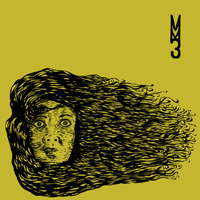
META META
META META 3 (jazz village 570122)
Tony Allen, the legendary drummer, called Metá Metá "the inventors of the new music scene in Brazil," after he jammed with them in 2013. Since their formation in São Paulo in 2008, Metá Metá have blended hard rock, punk, with more traditional Brasilian rhythms and avant jazz into a high-energy mix. MM3, their third album, presses their musical agenda while singing about corruption in Brazilian society. Most people however don't pay attention to the lyrics unless they are cringeworthy ballads. But while ignoring the lyrics I do notice one song is called "Angoulème" and another "Angolana," which to me suggests the ritzy world of the French autumn jazz festival on the one hand and the hardship of the forgotten south African land that was once a proud sister of Brasil on the other. The solid percussion underpinning is their main asset. But the crazy sax player is also engaging: he reminds me of James Chance of James White & the Blacks, though some say Chance never knew how to actually play the sax -- he just blew into it with all his might, but there was certainly a lot of energy in that band -- and in James Chance and Les Contortionists, his other No Wave punk band. I wasn't sure I could listen to a whole disc of this, so after a few tracks I put it on pause and sought them on YouTube to try to figure out what I was hearing. Seeing is believing, and can help your hearing, no? Their December 2013 live show is really hot and shows the high energy drummer, though the singer is occasionally off key (a problem with live performing is you often cannot hear the monitors). The album grew on me though, as the stronger tracks are at the end; and it goes out raving with the electric guitar putting up a wall of sound with his pedals on, and the sax getting moody as hell instead of going all Ornate and blow-it-out-yer-assy. Not suited for every mood, but stick with it, and I think it will click.

DONA ONETE
BANZEIRO (MaisUmDiscos)
How thrilling to have a new album from the great Brasilian songstress Dona Onete. I asked my Brasilian music expert what the name of her indigenous rhythm is, You know it, he replied, it's called Ska! It does indeed have that Specials quotient going on. Amazingly the 78 year old Dona (Ionete da Silveira Gama) does keep up with the band. Onete wrote ten of the dozen songs here which were recorded in Bethlehem (Pennsylvania). The title cut is in the Bhang rhythm (sic) apparently brought from Africa to the new world, but most of the other tunes are in bolero and carimbó rhythms according to one source. "Banzeiro" means wake, not in the funeral sense, but in the way boats send out ripples as they move in the tide; it's also the name of the barque in the lovely cover image. "Proposta indecente" -- I don't need to translate that for you -- has a wonderful tropical drum machine aesthetic (guiro, bongo and clave) with Farfisa which is nostalgic (for anyone who remembers rhythm settings on organs) but still seems a fresh approach to bolero -- or maybe this is the carimbó track! This must be great live. The same rhythm, reminiscent of morna music from Cabo Verde (especially with her raspy voice which echoes Cesária Evora) is employed for "Coração Brechó". Her careworn voice, in fact, also reminds me of the Jolly Boys' singer Albert Minott so it puts me in a good mood. (From July 5 the disc will be available for free listen or download from the Musical Natura website.)
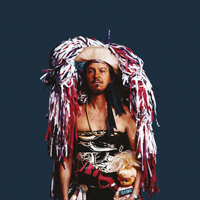
SIBA
DE BAILE SOLTO (YbM Music / Polysom P0566)
Polysom is the last vinyl manufacturer of South America. Since 2010, they've also operated as an independent record label and they have an impressive catalogue. Not sure how you can track this one down on vinyl if you are not in Brasil. There's amazon's lame MP3 download if you are happy with cheap earbud quality sound, but if that's the case, Siba gives away all his discs in low quality on his website. Siba who used to front Mestre Ambrosio, sings and plays guitar and delivers a blend of rock and maracatu -- the traditional Pernambucan sounds. His lyrics are politically engaged, protesting deforestation, which is finally a hot topic in most of Brasil. Violence, consumerism, over-reaching authority, and social inequality are among his other themes delivered over an interesting mix of electric and acoustic instruments: hand percussion and a pair of dueling guitars that seem differently tuned and would not be out of place on a Nigerian stage with Orlando Owoh. Also did I mention tuba bass? It's rocking. His voice is sometimes tentative which lends appeal to the plaintive pop ballad "Tres Carmelitas." A song about a spider and a jar ("A Jarra e a Aranha") rehearses an old tongue-twister ("arranhar" is to scratch; "aranha" is spider; "jarra" is jar). This is a very catchy and varied album and the more I play it the more I like it.

DANIELA MERCURY
VINIL VIRTUAL (Biscoito Fino)
Daniela Mercury has been at it for decades, but there's enough new ideas here to make her latest release worth checking out. It's predictable, which is good if you are a best-selling artist; it's not quite MPB, but a mix of samba-reggae and pop, with occasional outbursts of axé -- to me, the most interesting aspect of Brasilian carnaval music. 16 years ago I used my press credentials to get backstage at her bloco and met the lady; my Portuguese was unacceptable and she didn't speak English, but see how far we've come. "Frogs in the sky" is sung in English though it makes as much sense as a Sarah Palin campaign speech, if a bit more left wing: "Love is freedom... No violence... peace and love." Her impetus, she says, was the Annie Leibovitz photo of John and Yoko on the cover of rolling stone which spoke to her about peace and love. OK, I am losing my mind, "Alegria e Lamento" starts out like "Hotel California." Get me outta here. "De Deus, de Alah, de Gilberto Gil" is haunting. Warning: earworms ahead. Time to move on. "Antropofágicos São Paulistanos" seems to be about the cannibals of São Paulo. It has the heavy insistent axé drumming I was talking about. Truly old-school Hohner clavinet (à la Stevie Wonder) rips up the intro to "O Riso de Deus (God's smile)" which also has popping bass and the drumming bedrock, this time singing more favorably about Rio. The title track is a rap, sort of. Well more of a spoken thing over outré jazz piano, but the full force of her skill as a singer is brought to bear on "Tres Vozes" where she brings in Olodum on the battery. I am not sure of the heavy rock influence on "Minha Mãe, Minha Pátria" since I never listened to Queen or AC/DC, but I suspect it's in there somewhere. Overall, a varied and worthwhile enterprise.

CABRUERA
COLORS OF BRAZIL (Tumi Music TUMI239)
It's been a decade since we last heard from Cabruêra outside their homeland on the sensational Probido Cochilar album, subtitled "Sambas for Sleepless Nights," on Piranha. They come storming back with a vivid landscape that sounds like a rock and roll movie soundtrack. It's hot and bright, like the title suggests, and spills over in all directions requiring two albums to present it all (The first of the two discs, titled Visagem came out in Brasil in 2010; the second, known as Nordeste Oculto was released in 2013). The band was created in Northeastern Brasil, in the city of Campina Grande, Paraiba, to reinvigorate local folk music. In addition to the core group of founder Arthur Pessoa on vocals, accordion (that's the traditional aspect!) and his trademark ballpoint-pen guitar, which is a vibrato-like tremelo sound he has invented, bassist Edy Gonzaga, drummer Pablo Ramires and second guitar Léo Marinho, there are twenty or so guests, notably trumpet and trombone, but also sitar, more percussion, more vocals, more guitars, keyboards, and more brass. Their name means herd of goats (referring to the wild critters who chew up the dry landscape of their homeland), but it is also a slang term and suggests the gang of famous outlaw Lampiao, the Robin Hood of Northeastern Brasil, much celebrated in popular literature, the Livros do Cordel, which I have written about elsewhere. Speaking of the cordels, which are printed versions of sung cutting contests or doggerel poems about current events, a typical song, "Embolada," has elements of samba with a reggae guitar and funk bassline, and seems related to the cordel tradition. Between rapidfire lyrics, Pessoa plays a lyric accordeon. But then the bic comes out for the guitar wobble and an electronic intro turns into a ska rave with frevo overtones on "A Pisada." Disc two, "Nordeste Oculto," starts with the sitar and tabla tracks, a bit of hippie nostalgia, reminiscent of "See My Friends," and a respite from the heavy stuff, but not altogether a success. Little bursts of declamatory poetry with guitar interspersed on disc two suggest that indeed Cabruêra is presenting some of the repentistas (authors of the cordels), as well as his more atmospheric tracks. We go gentle into the night with more twanging sitar and some fuzztone distortion. The second disc is more of a showcase of other performers in contrast to the driving rock of the main act. It's certainly colorful.